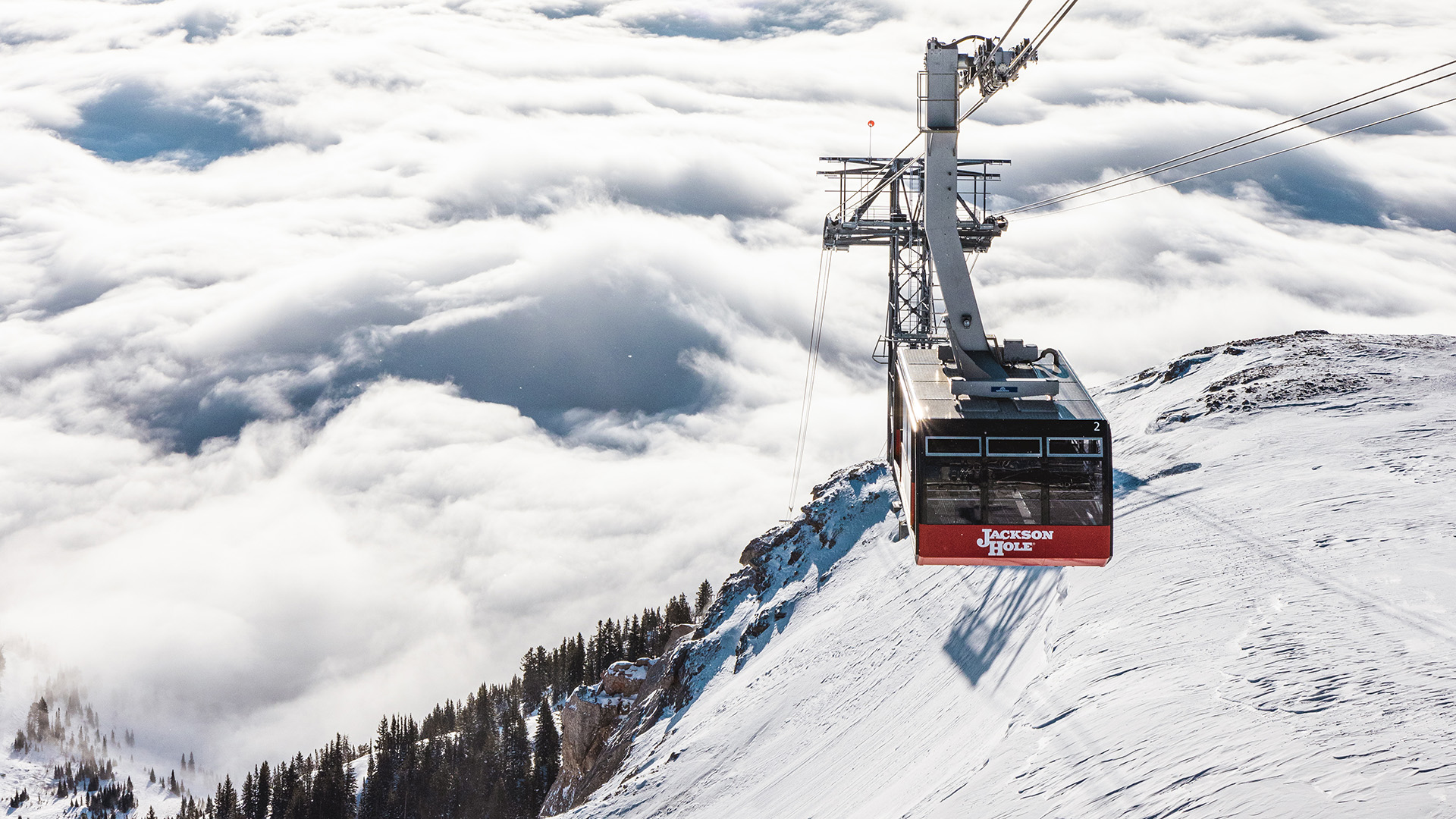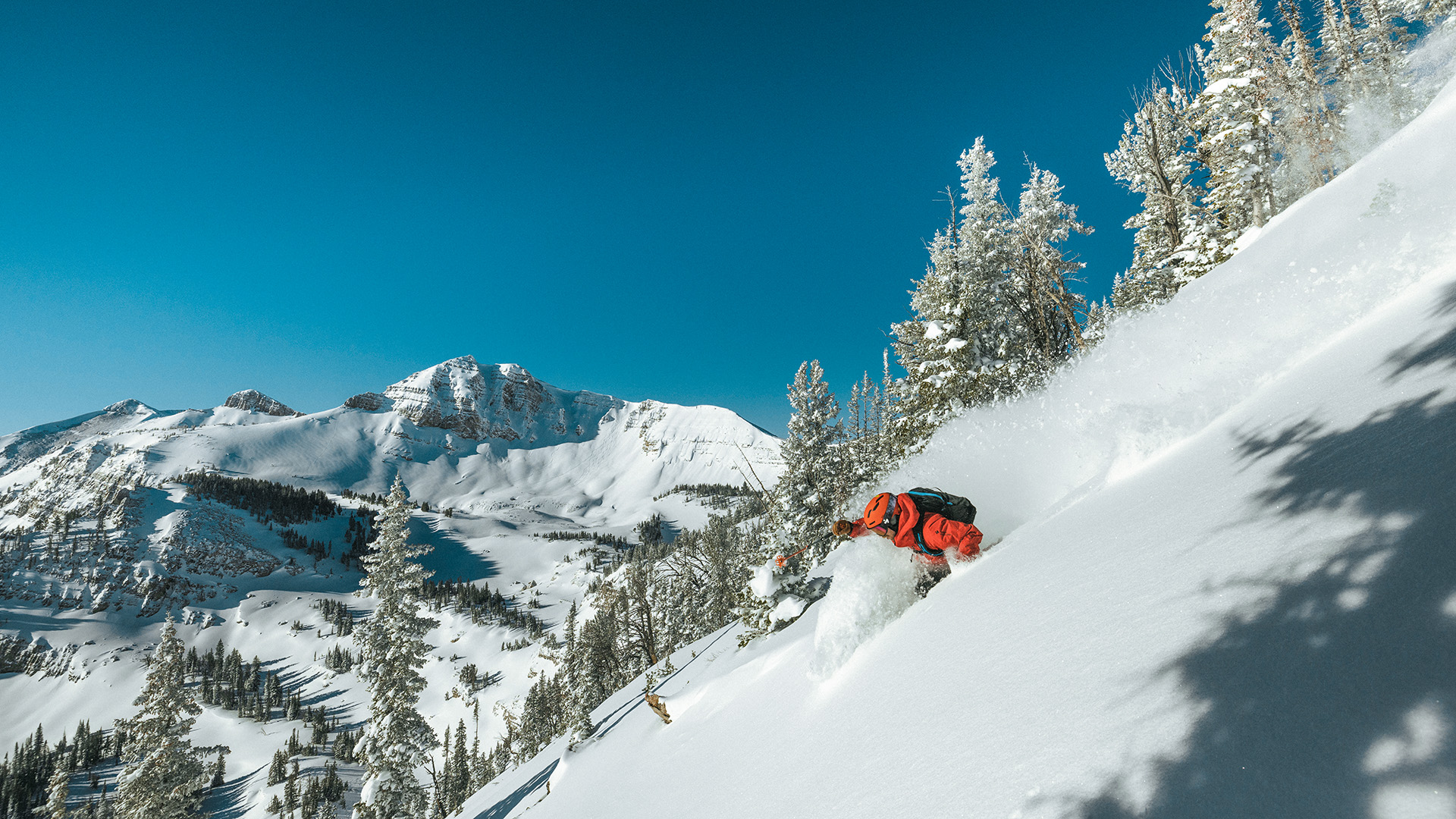
DENIS SEGUIN VISITS JACKSON HOLE TO INVESTIGATE WHETHER THERE IS SUCH A THING AS TOO MUCH POWDER
Many years ago, when I was a liftee at Sunshine Village, vagabond skiers would pass through Banff telling tales of a mythical place south of the border, in the great empty of Wyoming, with hills as steep as the powder was copious. What was this wondrous place, this skier’s ski resort? Jackson Hole. So, when one night last January my neighbour called and said he had slope-side accommodation at Jackson Hole Mountain Resort (JHMR), I booked my flight within the hour.
“Hole” is a frontier term for a large mountain valley. It’s a small word for a big place, in this case a high-altitude valley between the Tetons to the west and Gros Ventre range to the east. Most of the names in the area came from French-Canadian trappers, lonely men to be sure: Tetons refers to Les Trois Tetons or the three breasts. Gros Ventre means big belly. But an American beaver trapper, Davy Jackson, got the naming rights.
TAKING MEASURE
Our first day was a “bluebird,” as our mountain guide called it. Giles Lajevic-Augustine hustled us onto the Sweetwater gondola to begin a sweep of the resort, south to north, on runs titled Moran, Crags and Wide Open. After a few laps, we grasped the relative nature of ski run classification. Jackson Hole has a difficulty matrix of 50-40-10, representing the percentage of expert, intermediate and beginner runs. But a blue square at Jackson Hole is another resort’s black diamond.
Giles dove in and we dove after. Sundog. Sundance. Ranger. All the while, he took our measure. He was mostly complimentary. He gave us a tutorial on angulation, the key to keeping the skis from chattering even on the steepest terrain. Amphitheater. Laramie Bowl. Bivouac. By lunch, we’d skied 5,500 vertical metres.
More than five thousand. In a morning. It didn’t seem possible.
At lunch, JHMR sales manager Shannon Schiner explained how this is not just possible but typical. The old Thunder chairlift took 11 minutes to move riders 1,100m. Its 2022 high-speed replacement now covers the same distance in less than a third the time. But as every skier on a crowded hill knows, it’s not just the speed of the lifts but the length of time you wait for them. JHMR aims for an average lift wait time of three minutes. You read that correctly: 180 seconds. But that’s the gold-plated service you might expect for a lift ticket of US$255. And you read that correctly, too.
I kept lunch light to stay sharp for the afternoon. With Giles leading the charge, we dropped another 3,000m of vertical before we called it a day. When we told him we were staying at the Four Seasons Jackson Hole, Giles suggested we keep the instruction going into après-ski. “I’ll show you my recovery routine,” he said.
I was looking forward to a local craft beer but instead found myself in a scalding steam room for, as Giles instructed, “as long as you can stand it.” Then it was time to plunge into the ice bath for “as long as you can stand it.” Then back into the steam room. And then back into the ice bath. Like blue squares and black diamonds, “as long as you can stand it” is a relative measurement. My second plunge into the ice bath lasted as long as it took me to climb out. While we recovered in the hot tub, Giles continued his cold-water immersion to the point I feared for any of his future offspring.
That night after dinner, we stood outside watching the lights of the grooming fleet cutting through a thickening snowfall. I sipped my bourbon and contemplated a day unmatched since my bygone liftee days. I hadn’t skied so much, so hard, so well, in decades. Sublime.

CALL THE PARAMEDICS
The next day was ridiculous. By noon, I was in white-out conditions buried in powder on a double-black diamond and ready to call the paramedics.
It all came down to “two angry inches.” This was Giles’ term for a major meteorological miss. The forecast was for two inches; we got 14 at the base. In the glades, we were hopping happily through thigh-high. Giles pulled out his phone to capture the moments on video. We were as giddy as kids in an endless bouncy castle. As we rode the Thunder chair for run number three, Giles announced it was time to try a double-black.
Giles is a 10-year veteran of Jackson Hole and is hard-core, a multi-discipline mountain man whose idea of a good time is climbing a peak with his skis strapped to his back and then skiing down… and then doing it again. One year he had 300 ski days. This is the kind of experience you want in a guide, especially at Jackson Hole. But a double-black diamond?
My friend and I exchanged glances. Really, Giles? Really. At the top of the chair, visibility was nil. The air itself was powder. We bobbed down, skiing by braille, catching glimpses of Giles through the flakes. He came to a stop, a break in the trees. We looked down. This is Tower Three Chute. Just follow me. He didn’t say the words. He used telepathy.
I tipped my skis over the edge and dropped. The powder was above my waist. It was something closer to swimming than skiing. Then I felt an unpleasant looseness under my right boot, a belated reminder to crank my bindings. The combination of 1.2m of snow on a 30-degree mogul field was too much for my heel piece.
Releasing a ski in that depth can mean you’re calling the resort in July to see if they found your missing plank. But I wasn’t worried about a stray Völkl. My other ski, still attached to my boot, had ploughed into the hillside at 45 degrees in the opposite direction. I may as well have hammered a piton into a rock face.
It was ridiculous. It was painful. It was humbling. The more I struggled, the deeper I sank. At one point I was buried completely, staring through goggles into white translucence thinking that perhaps there is such a thing as too much powder. I used up a day’s worth of energy extricating myself from Tower Three Chute. I could barely eat lunch. “I’m glad you used your hands to pull your ski out,” said Giles, sipping his green tea and honey. “I had someone tear a ligament trying to yank out a stuck ski.” He shared some mountain horror stories to restore our sense of perspective, like the off-piste trio who went one, two, three off a 130m cliff and survived. Sometimes there is no such thing as too much powder.
Day three was a gift from the ski gods. We had to give up Giles—he and his wife were climbing and skiing in the backcountry—but it was another bluebird. Thanks to his guidance we knew our way around the mountain. We relived past glories and tested new terrain. We avoided Tower Three Chute. Day two’s dump had been groomed to perfection. Bivouac, a beast of bumps on our first day, had been smoothed, providing a steep canvas for hop turns that left our legs screaming stop. The ski concierge at our hotel nodded his understanding as we passed our equipment over. They would be there for us first thing tomorrow.
Another day seemed ridiculous. But it was sublime.
MOUNTAIN STATS
Vertical drop: 1,261m
Summit elevation: 3,185m
Base elevation: 1,924m
Terrain: 1,010ha on two mountains and more than 1,200ha of backcountry
How to get there: Canadians can connect to Jackson from Seattle, Chicago and Denver. JHMR is a 35-minute drive from Jackson Hole Airport.




